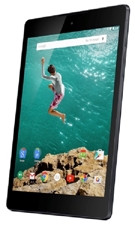
Google entered the tablet arena in 2012 with its Nexus 7 tablet. The device, which was manufactured by Asus, became a worldwide success. Only a few months later, the Nexus 10 was launched, this time produced by Samsung. It's now two years later and Google is back in business with a third Nexus tablet. How does it compare to other tablets and is it any good for business use?
I took it for a comprehensive test run and benchmarked the performance and quality of the hardware, screen and battery using industry-standard tools and software. Although the Nexus 9 comes in four different versions, 16GB/32GB and WiFi/WiFi + LTE, I only used the 16GB WiFi model for this review.
Minimalistic look
The new 8.9-inch Nexus 9 tablet is the result of collaboration between Google and HTC. Google focused primarily on the design of the device, while HTC was responsible for the production. The only visible design contribution from HTC is the speakers. The Nexus 9 houses two front-facing speakers, one on each side. For a tablet, these speakers are able to produce pretty good sound quality and volume. They do, however, fall short in the low frequency range.
Design-wise, the Nexus 9 shares some similarities with previous models. It's got the traditional minimalistic exterior and light grey plastic back cover with "Nexus" on it. Nonetheless, it feels quite solid and durable. The tablet should have no problem surviving rough days at the office or business trips.
The Nexus 9 doesn't have a widescreen (16:10) format display, like most modern, similar devices. Instead, the screen dimensions (4:3) are more like that of the Apple iPad. For typical office use, this screen aspect ratio has some advantages. Because the aspect ratio offers some extra vertical space, the screen can display more information at the same time, so there is less need to scroll up or down. This is especially handy for business users who often handle PDFs, e-books, documents or spreadsheets. Movie fanatics will have to deal with black bars since most Hollywood productions are shot in widescreen format.
The Nexus 9 weighs in at only 425g (WiFi version) and is 7.95mm thick, making it slightly lighter and a bit thicker than the new Apple iPad Air 2. These dimensions facilitate holding it with just one hand. For comfortable use, it still requires two hands.
Android 5.0 'Lollipop'
Google's Android recently reached version 5.0, and the Nexus 9 tablet is the first official device to be installed with the operating system. Android 5.0, nicknamed Lollipop, is designed to run on almost any device, from smart watches to new smart TVs and in cars.
One of the most eye-catching novelties in Android 5.0 is the new design philosophy, labelled "Material Design", which makes the standard Android user interface look more polished and playful. The downside is that it also needs more processing power and isn't without its flaws, yet. The Nexus 9 test model I used for this review showed some occasional stuttering when I switched between apps or started a new one. Hopefully, this glitch will be fixed with a future update.

Android 5.0 now offers a do-not-disturb option, especially handy for when you are on a tight deadline. It is possible to lock the complete device, except for just one app. This feature is very useful when lending it to a colleague - when you don't want to give access to all your confidential and/or personal data. Another nice feature - double-tapping on the screen now turns on the device.
Under the hood, Google has also made some drastic improvements. Without going into too much technical detail, Android 5 features enhanced processor, memory and storage management that (in theory) should result in improved performance. Demanding business users with older Android tablets or phones are definitely advised to upgrade to Android 5.0 when it is available for their specific device.
Google also sharpened its set of security features in Android 5.0, which is good news for business users who store confidential, corporate or personal data on their devices. When a password, unlock pattern or pin code is installed on the Android 5.0 device, it automatically, and by default, encrypts all data that is stored on it. Google claims the associated decryption key is not stored online, but only on the device itself.
These are just some of the most obvious novelties Android 5.0 Lollipop delivers. For a detailed overview, visit the official Google Android 5.0 product page.
Under the hood
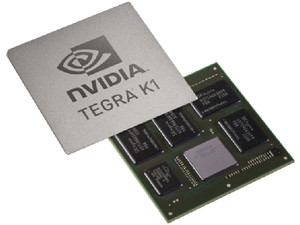
Google's Nexus 9 tablet is the first device to feature an advanced 64-bit Nvidia Tegra K1-chip. It is the first of its kind that is specifically designed for the Android operating system. The Tegra K1 houses two separate processing cores, each clocked at 2.3GHz, and one graphical processing unit (gpu). The tablet is also equipped with 2GB of RAM.
Google and/or HTC decided to fit the cheapest version of the Nexus 9 with only 16GB of storage space that can't be expanded afterwards by using a separate memory card. Since Android 5.0 needs 4GB, business users will run out of space relatively quickly, because apps and documents in general are steadily increasing in size as a result of higher screen and camera resolution. On the other hand, the prices of flash memory chips have dropped considerably in the last couple of years. Therefore, I find it disappointing to see that the cheapest version of the Nexus 9 only has 16GB on board. I also would have liked to see versions of the Nexus 9 with 64GB or even 128GB storage capacity to make it even more future-proof.
Fastest Android tablet
To measure how the dual-core Tegra K1 chip performs in real-life, I used a set of benchmarking tools and software. The first one (Geekbench) simulates real-world business and consumer scenarios to determine how powerful the hardware actually is. It illustrated that the Nexus 9 is the fastest Android tablet at the moment, even beating devices fitted with a quad-core chip. According to Geekbench, only the new iPad Air 2 (triple-core) performs significantly better than the Nexus 9.
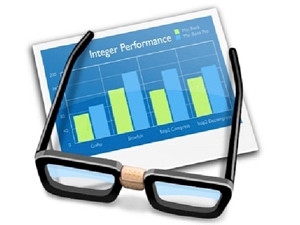
I then ran the Nexus 9 through the Kraken benchmark tool, which also factors in the operating system and the browser. This is clearly where the Nexus 9 shows its muscle, by beating not only the Apple iPad Air 2, but also every other tablet available at the moment. The third benchmark tool I used is called Peacekeeper and also measures the hardware, operating system and browser. It showed the same outcome as Geekbench, meaning the Nexus 9 is the fastest Android tablet at the moment. The only device to beat the Nexus 9 in the Peacekeeper test is, again, the Apple iPad Air 2.
The final benchmark test I ran is called GFXBench and is specifically aimed at mapping the graphical performance of the Nexus 9. Just as with the Geekbench and Peacekeeper software, I got the same result. The Nexus 9 beats all other tablets hands down, except for the Apple iPad Air 2.
Business users looking for a new tablet to do typical office tasks like browsing, communicating and reading or editing documents will not benefit from all the horsepower residing within the Nexus 9, although it's always nice to know the device can handle more than what it currently is used for. Only demanding business users that also plan to do HD photo or video editing and play the occasional 3D game will profit from its power.
Backlight bleeding
The 8.9-inch screen of the Nexus 9 has the exact same resolution (2 048 x 1 536) as the iPad Air 2. Because it is slightly smaller than the 9.7-inch one on the iPad Air 2, the pixel density (288ppi) is somewhat higher. This results in razor-sharp images and text, making the Nexus 9 ideal for business and office use. According to the special colorimeter, the brightness, contrast and colour reproduction of the Nexus 9 are also excellent.
Unfortunately, the screen of the 16GB test model I used for this review had a minor flaw. At the top of the screen, I noticed considerably more brightness than in any other position. This unfortunate phenomenon is called "backlight-bleeding" and means light being produced behind the display panel leaks at the edges. A quick scan on the Internet taught me that more people have reported the issue, sadly making it a structural flaw instead of an incidental one.
When using the Nexus 9 in a well-lit office, the backlight-bleeding effect is completely invisible. It will only catch your eye when the Nexus 9 is used in low-light situations.
Battery life
Battery life is a key consideration for business users. Google and/or HTC fitted the Nexus 9 with a relatively large 6 700mAh battery, roughly the same capacity as the Apple iPad Air 2 and Apple iPad Mini 3. Fully charging it can take quite long (five hours), mainly because the power adapter that comes with it is seriously underpowered.
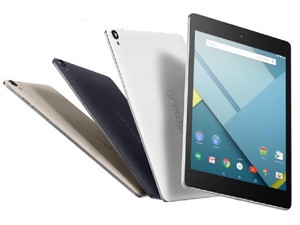
According to Google, the Nexus 9 should last almost 10 hours. To take that to the test, I ran the Nexus 9 through my specialised benchmarking script that uses typical office activities to drain the battery as fast as possible.
I found the Nexus 9 survived for only six hours and 45 minutes. In real-life, this would convert roughly into nine hours of typical business tasks. The Nexus 9 should therefore have no trouble reaching the end of the workday, including some overtime. Similar devices that performed better according to the test are the Samsung Galaxy Tab Pro 10.1 (11.5 hours), iPad Mini 3 (nine hours), Galaxy Note 10.1 (2014 edition) (8.5 hours), iPad Air 1 (7.5 hours) and iPad Air 2 (seven hours).
I also used the benchmark software to find out specifically how long the Nexus 9 could play 720p HD videos - it lasted a whopping 10 hours and 35 minutes. Devices that lasted longer when watching videos were the Samsung Galaxy Tab S 10.5 (14 hours), Tab S 8.4 (12.5 hours).
Camera
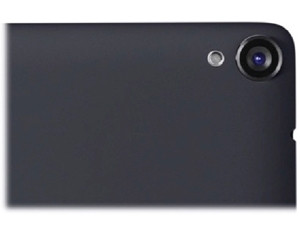
The Nexus 9 features a somewhat protruding rear camera lens. This, however, doesn't cause a problem, like with the iPhone 6, because the edges of the Nexus 9 backside are slightly curved. The auto-focusing 8MP camera of the Nexus 9 is accompanied by an LED flash to aid the tablet in low-light scenarios. The Android 5.0 camera app is quite minimalistic, but easily accessible through a shortcut on the lock screen.
The test photos I took with the 8MP rear camera were quite sharp and showed realistic colours. In a low-light situation, the Nexus 9 camera wasn't able to impress me.
The darker it got, the more digital noise became visible, resulting in grainy photos. Not even the LED flash was able to help the camera in low-light situations because of its limited range and slow response. The auto-focus also shows room for improvement, since it took several seconds to finally determine the optimal focal point. For business trips, corporate events, meetings or the occasional office birthday party, the rear camera of the Nexus 9 should be adequate, though.
The 1.6MP front-facing camera is mostly used for video calling, like Skype. Although the quality it produces is more than sufficient for most business video conferencing calls, don't expect too much from it, especially in a light deprived office. The full-HD (1080p) videos I shot using the Nexus 9 showed more than enough quality for the occasional home or business moment. In low-light situations, though, the quality quickly diminished.
Verdict
The Nexus 9 is a compact, lightweight powerhouse with a near perfect screen, great sounding speakers and adequate battery life to reach the end of a day at the office, including an hour of overtime. To top it all off, it comes pre-installed with the latest Android version that offers a lot of innovation and new features.
It does have some flaws, though, with the backlight bleeding and meagre, non-expandable storage capacity being the two biggest. Fortunately, the backlight bleeding only reveals itself in the dark and therefore won't pose a problem for most business users. Movie fanatics should stay clear of the Nexus 9 because of the background bleeding effect and the 4:3 screen format.
In the end, the Nexus 9 is ideal for demanding business users looking for an Android tablet that houses a lot of processing power in combination with a high-resolution screen. If that's not you, look around for similar tablets in the same, or even lower, price range.
Share